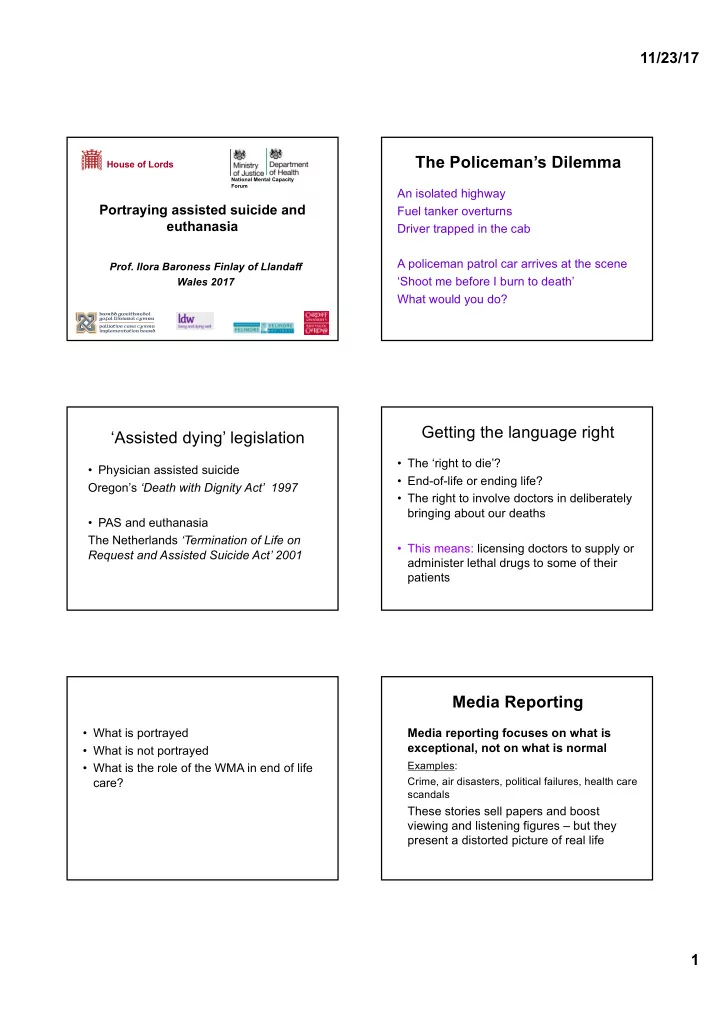

11/23/17 The Policeman’s Dilemma House of Lords National Mental Capacity Forum An isolated highway Portraying assisted suicide and Fuel tanker overturns euthanasia Driver trapped in the cab A policeman patrol car arrives at the scene Prof. Ilora Baroness Finlay of Llandaff ‘Shoot me before I burn to death’ Wales 2017 What would you do? Getting the language right ‘Assisted dying’ legislation • The ‘right to die’? • Physician assisted suicide • End-of-life or ending life? Oregon’s ‘Death with Dignity Act’ 1997 • The right to involve doctors in deliberately bringing about our deaths • PAS and euthanasia The Netherlands ‘Termination of Life on • This means: licensing doctors to supply or Request and Assisted Suicide Act’ 2001 administer lethal drugs to some of their patients Media Reporting • What is portrayed Media reporting focuses on what is exceptional, not on what is normal • What is not portrayed Examples: • What is the role of the WMA in end of life care? Crime, air disasters, political failures, health care scandals These stories sell papers and boost viewing and listening figures – but they present a distorted picture of real life 1
11/23/17 Heroes and Villains The Human Interest Dimension “Journalists like to show ordinary people News: increasingly encouraging empathy / feeling rather behaving like heroes, or being ‘victims’ in than analysing facts and stimulating thought. need of rescue, in this case from the Professor Seale again : deterioration of their own bodies and from “A degree of voyeurism is involved in press reporting of those who will not accede to requests for serious and terminal illness, and this too requires assisted dying, who are thereby personal stories about dying people rather than dry constituted as ‘villains’” outlines of general ethical debates. The prominence of particular personal accounts then encourages readers to (Professor Clive Seale “ How the mass media report social statistics: believe that these are typical of all such experiences.” A case study concerning research on end-of-life decisions”, Social Science and Medicine, 2010) Public Opinion Surveys Knowledge of the Subject Q. Where does most public knowledge of Two Key Questions : the ‘assisted dying’ debate come from? What do respondents know about A. The media the subject under discussion? Q. What do we learn from the media? A. That death is agonising, that the law is cruel and that most people say they want How is the question phrased? it to be changed Q. So what do we tell the opinion polls? Shaping the Question Shaping the Question “ A proposed new law would allow terminally ill “ A proposed new law would allow terminally ill adults the option of assisted dying. This would adults the option of assisted dying. This would mean being provided with life-ending mean being provided with life-ending medication, to take themselves, if two doctors medication , to take themselves, if two doctors thought they met all of the safeguards. They thought they met all of the safeguards . They would need to be of sound mind, be terminally ill would need to be of sound mind , be terminally and have 6 months or less to live, and a High ill and have 6 months or less to live, and a High Court judge would have to be satisfied that they Court judge would have to be satisfied that had made a voluntary, clear and settled decision they had made a voluntary , clear and settled to end their life, with time to consider all other decision to end their life, with time to consider all options.” other options.” (Online poll, Dignity in Dying, UK 2015) (Online poll, Dignity in Dying, UK 2015) 2
11/23/17 Reasons are social – can a What drives a desire for death? doctor judge them? • No longer enjoying life, hopelessness, fear of • Feeling a burden: low correlation with physical symptoms dying, family social considerations, fears of (r = 0.02-0.24) and higher correlations with psychological problems (r being burden, dependent on family including = 0.35-0.39) and existential issues (r = 0.45-0.49) Wilson KG et al A burden to others: a common source of distress for the terminally ill. financially 2005;34(2):115-23. • Depression and hopelessness are mutually Lorenz et al JAMA 2003 289 2282 reinforcing, independent predictors • Maintaining control, loss of function, autonomy, meaning Rodin G et al Pathways to distress: the multiple determinants of depression, hopelessness, and the desire for hastened death in metastatic cancer patients 2014 e-pub Sullivan AD et al NEJM 2000 342 598-604 • Major depression(p<.001) • Cry for help “desire to live but not this way” Wilson KG et al. Desire for euthanasia or physician-assisted suicide in palliative cancer PLoS One 2012 7 e37117 care. 2007;26(3):314-23 Is this a matter for doctors? What does it involve? 1. Gatekeeper and 2. Supplier PAS Euthanasia Most of the judgements involved are social not • Patient self- • Inject short-acting medical administers anaesthetic to coma Trust is the problem • Barbiturate in • May follow with massive overdose pancuronium Oregon: Patient completely paralysed ‘ Less able to engage in activities making life enjoyable’ (90%) • Not soluble - tumbler Any distress not visible to onlooker Tastes bitter ‘Losing autonomy’ (91%) Die of asphyxia • Preload with ‘Loss of dignity’ (77%) antiemetic Oregon population 3.8m Netherlands population 16.8 m. Notification since 2002 7000 6000 Plus 54 5000 ingestion status unknown 4000 3000 2000 1000 0 2002 2003 2004 2005 2006 2007 2008 2009 2010 2011 2012 2103 2014 2015 2016 http://www.euthanasiecommissie.nl/actueel/nieuws/2016/april/26/jaarverslag-2015-gepubliceerd 3
11/23/17 Laws – ‘Assisted dying’ The world situation – WMA • More than regulatory • Palliative care is an essential instruments component of healthcare • Send social messages BUT • Can have unintended • >40m people / year need consequences palliative care • 80% - no access to analgesia • 6% are children 4
Recommend
More recommend